The Colours of Curaçao
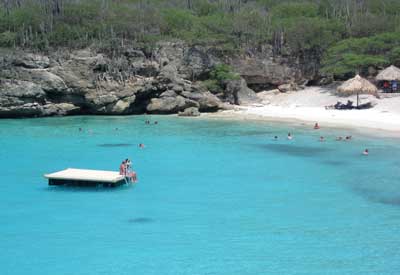
Story and photos by Mark Stevens
Curacao boasts a wealth of secluded and gorgeous beaches far from the madding crowd.
It’s nothing short of spectacular, this view of Willemstad’s waterfront from the stone ramparts high atop Riffort, an eighteenth-century bastion guarding the sea approaches to St. Ann Bay, one of the Caribbean’s biggest harbours.
A long pontoon pedestrian bridge named for Queen Emma, though locals are wont to call it “The Swinging Old Lady of Curacao,” spans the great bay, joining Otrabanda on this side to Punda, the historic downtown core.
The bridge crosses sun-golden and royal blue waters, leading to tall narrow buildings (tax rates were based on their width, just like in Holland)lined up along a promenade called Handelskade, boasting Dutch architecture that could hold its own in Amsterdam but for one anomaly.
The facades of theseBaroque colonial structures are painted teal and turquoise, coral and buttercup.
These are but a few of the colours of Curaçao.
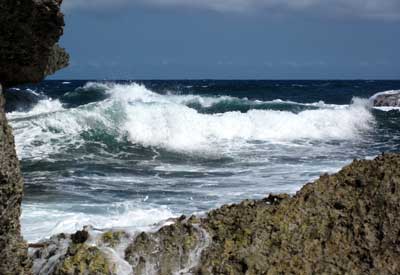 SheteBoka National Parks offers spectacular sea views amid a lunar landscape
SheteBoka National Parks offers spectacular sea views amid a lunar landscape
Funny story, the chronicle of this particular man-made rainbow.
In the early 1800s Albert Kikkert was posted here as governor of the Dutch Antilles. Prone to migraines, he decided the harsh sunlight on the whitewashed fronts of those buildings exacerbated his condition. He demanded that they be painted different colours.
The rest is history. History, it should be noted, is yet one more Curaçao leitmotif.
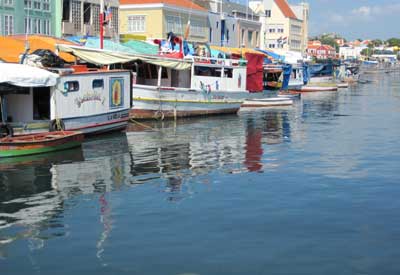 The floating market in downtown Willemsted is a must-do for local shoppers.
The floating market in downtown Willemsted is a must-do for local shoppers.
Witness the lemon-painted former mansion that houses the Curaçao Maritime Museum, a must for visitors with a nautical bent. Discover the story of the Arawaks, a chronicle of invasion and occupation that dates back half a millennium. Check out the artifacts salvaged from a Dutch shipwreck.
Or head down the street to the walls of Fort Amsterdam, visit government house, equally vivid in colour, equally rich in history. Check out the cannon ball still lodged in the walls of this august building, reputedly fired at the command of Captain Bligh.
If you’re a serious history buff you can take a self-guided historic walking tour of this city that first saw the light of day in 1634.
Or just enjoy this conflagration of colour and sound without rhyme or reason.
Follow the shoreline here to the floating market. Here boatsline the seawall – green, red, blue – hawking the catch of the day. Stroll the market where red tomatoes compete for attention with green peppers and yellow bananas, where the sounds are a distracting as the colours: Papiemento, a hybrid language of Dutch, French, Portuguese and even African dialect; staccato bursts of Spanish as locals and those Venezuelan fishermen haggle for the best deals.
But compared to the countryside, Willemstad itself is downright monochromatic.
Rolling hills dominate this landscape, punctuated by scrub vegetation like nearby Aruba and Bonaire (Curaçao reclines deep in the southwest Caribbean between her two sisters), highlighted by jade and sage-coloured towering cactus plants.
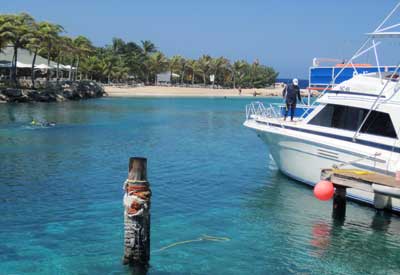 The waters of a blue lagoon nuzzle the shore hard by the Curacao Sea Aquarium, a Canadian-owned venture.
The waters of a blue lagoon nuzzle the shore hard by the Curacao Sea Aquarium, a Canadian-owned venture.
Colour Curaçao pink –a hundred flamingos, graceful, aloof, and vivid in the morning sun at the Flamingo Reserve at Willibrordus,stand sentinel in a smattering of ponds, ponds guarded by mesas that wouldn’t be out of place in Arizona.
Think desert beside an ocean.
Be titillated by thetints and huesof a place that’s combination kaleidoscope and history lesson: Nena Sanchez Gallery, housed in historic Landhuis Jan Kok – the Dutch answer to English colonial great houses.
Those ubiquitous cacti are littered haphazardly across the grounds, in contrast to the tiled pumpkin-coloured roof, the forest green shutters of the former plantation. They form dramatic backdrops to pastel-painted statues, whilethe colours inside come courtesy of the paintings of local artist Nena Sanchez, light-hearted works inspired by those Caribbean colours you’ve been inhaling for days, landscapes, seascapes and whimsical paintings of local fish.
For a first-hand view of those undersea colours that so inspired Sanchez, head to the Curaçao Sea Aquarium and nearby Substation Curaçao. Descend to the depths in a submarine or immerse yourself in those selfsame hues up close at the aquarium itself –maybe even take in a live dolphin show.
Paint Curaçao cobalt at Shete Boka, a National Park where you clamour across lunar landscapes and stare in awe as the seas throw themselves suicidally at cliffs and water-carved sculptures, where tympani roll sound track serenades you, where those tones take on a darker shade.
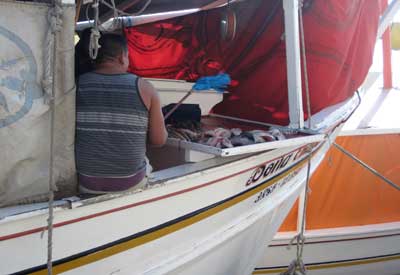 Venezuelan fisherman regularly put in to Curacao, selling the catch of the day to the highest bidder.
Venezuelan fisherman regularly put in to Curacao, selling the catch of the day to the highest bidder.
Marvel at the tapestry of tints at one of the island’s thirty-plus beaches, a wealth of watercolours worthy of Gauguin, of Matisse.
Colour Curacaosapphire at Playa Kenepa, snugged down at the base of rugged steep slopes, where those hues are so beautiful they could make a landlubber cry.
Colour it neon lime off Playa Porto Mari; think blushing accents to frame your view that are provided by blossoming bougainvillea, even more shades and tones adding to a resplendent painter’s palette that best defines this Dutch outpost, vivid as a rainbow, bright as a Caribbean sunset.
These are but a few of the colours of Curaçao.
.
NOTE: For more information on this vivid Caribbean oasis log on to www.curacao.com




























